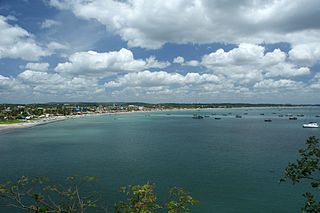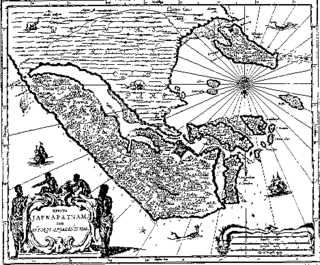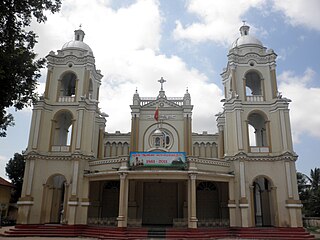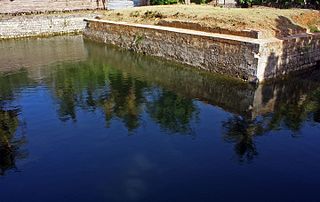
Ruins of the Jaffna Kingdom refer to the remains of the remaining building structures of the Jaffna Kingdom, the royal abode and structure of the ruling dynasty of the Kingdom of Jaffna, Nallur, Jaffna in Northern Sri Lanka.

Ruins of the Jaffna Kingdom refer to the remains of the remaining building structures of the Jaffna Kingdom, the royal abode and structure of the ruling dynasty of the Kingdom of Jaffna, Nallur, Jaffna in Northern Sri Lanka.
The palace was the home to the Aryacakravarti dynasty which became a powerful force in the North, North-East and the West of the islands prior to the conquest of the Portuguese into the island. [1]
According to Ibn Batuta, a renowned Moroccan historian, the kingdom had two capitals; Nallur was one and the other being Puttalam presently in the Western Province. [2] [3]

The construction of the Royal Palace has been ordered by Cinkai Ariyan Cekaracacekaran. But, another source says the palace and a flower garden was built by a Tamil king named Koolanghai in 104 AD. [4]
There were two main roadways and four temples at the four gateways that have now been destroyed. The rebuilt temples that exist now do not match their original locations which instead are occupied by churches erected by the Portuguese. The center of the city was Muthirai Santhai (market place) and was surrounded by a square fortification around it. There were courtly buildings for the kings, Brahmin priests, soldiers and other service providers in the palace premises. The old Nallur Kandaswamy temple functioned as a defensive fort with high walls. In general, the palace and the city was laid out like the traditional temple towns in South India. [4] [5]
The Jaffna Palace was significantly damaged during the Portuguese conquest of the Jaffna Kingdom. The fall of Cankili II, the last of the ruling dynasty at the hands of a 5,000 men-strong Portuguese invaders inevitably meant the fall of the Jaffna throne. [6]
Over the next 40 years, the Portuguese destroyed Hindu temples in the region, the royal repository of all literary output of the kingdom. Yamuna Eri, Cankili Thoppu archway, Ruins of the foundation of the Cankilian Thoppu and Mantri Manai are few of the only remaining parts of the palace apart from several small monuments that dot the compound. [7] [8]

Trincomalee, also known as Gokanna and Gokarna, is the administrative headquarters of the Trincomalee District and major resort port city of Eastern Province, Sri Lanka. Located on the east coast of the island overlooking the Trincomalee Harbour, 237 kilometres (147 mi) north-east of Colombo, 182 kilometres (113 mi) south-east of Jaffna and 111 kilometres (69 mi) miles north of Batticaloa, Trincomalee has been one of the main centres of Sri Lankan Tamil language speaking culture on the island for over two millennia. With a population of 99,135, the city is built on a peninsula of the same name, which divides its inner and outer harbours. People from Trincomalee are known as Trincomalians and the local authority is Trincomalee Urban Council. Trincomalee city is home to the famous Koneswaram temple from where it developed and earned its historic Tamil name Thirukonamalai. The town is home to other historical monuments such as the Bhadrakali Amman Temple, Trincomalee, the Trincomalee Hindu Cultural Hall and, opened in 1897, the Trincomalee Hindu College. Trincomalee is also the site of the Trincomalee railway station and an ancient ferry service to Jaffna and the south side of the harbour at Muttur.

Nallur Kandaswamy Kovil is a significant Hindu temple, located in Nallur, Northern Province, Sri Lanka. The presiding deity is Lord Murugan in the form of the holy 'Vel' in the Sanctum, the primary shrine, and in other forms, namely, Shanmugar, Muthukumaraswami, Valli Kaanthar with consorts Valli and Deivayanai, and Thandayuthapani, sans consorts in secondary shrines in the temple.

The Jaffna Kingdom, also known as Kingdom of Aryachakravarti, was a historical kingdom of what today is northern Sri Lanka. It came into existence around the town of Jaffna on the Jaffna peninsula and was traditionally thought to have been established after the invasion of Kalinga Magha from Kalinga in India. Established as a powerful force in the north, northeast and west of the island, it eventually became a tribute-paying feudatory of the Pandyan Empire in modern South India in 1258, gaining independence when the last Pandyan ruler of Madurai was defeated and expelled in 1323 by Malik Kafur, the army general of the Delhi Sultanate. For a brief period in the early to mid-14th century it was an ascendant power in the island of Sri Lanka, to which all regional kingdoms accepted subordination. However, the kingdom was overpowered by the rival Kotte Kingdom around 1450 when it was invaded by Prince Sapumal under the orders of Parakramabahu VI.

The Arya Chakravarti dynasty were kings of the Jaffna Kingdom in Sri Lanka. The earliest Sri Lankan sources, between 1277 and 1283, mention a military leader of this name as a minister in the services of the Pandyan Empire; he raided the western Sri Lankan coast and took the politically significant relic of the Buddha's tooth from the Sinhalese capital city of Yapahuwa. Political and military leaders of the same family name left a number of inscriptions in the modern-day Tamil Nadu state, with dates ranging from 1272 to 1305, during the late Pandyan Empire. According to contemporary native literature, such as Cekaracecekaramalai, the family also claimed lineage from the Tamil Brahmins of the prominent Hindu pilgrimage temple of Rameswaram in the modern Ramanathapuram District of India. They ruled the Jaffna kingdom from the 13th until the 17th century, when the last of the dynasty, Cankili II, was ousted by the Portuguese.
Karaiyar is a Sri Lankan Tamil caste found mainly on the northern and eastern coastal areas of Sri Lanka, and globally among the Tamil diaspora.

Cankili I, also known as Segarasasekaram, is the most remembered Jaffna kingdom king in the Sri Lankan Tamil history. He was very active in resisting Portuguese colonial inroads into Sri Lanka. He also inherited his throne via palace intrigues in which number of heirs apparent died under mysterious circumstances. At the end, he was removed from power by a local uprising that led to his son Puviraja Pandaram taking nominal power from him.
Nallur is an affluent suburb in Jaffna, Sri Lanka. It is located 3 km south from Jaffna city centre. Nallur is most famous for Nallur Kandaswamy temple, one of Sri Lanka's most sacred place of pilgrimage for Sri Lankan Hindus. Nallur is also famous for being the historical capital of the old Jaffna Kingdom and birthplace of renowned philosopher and theologian, Arumuka Navalar.

Cankili II was the last king of the Jaffna kingdom and was a usurper who came to throne with a palace massacre of the royal prince and the regent Arasa-kesari in 1617. His regency was rejected by the Portuguese colonials in Colombo, Sri Lanka. His reign was secured with military forces from the Thanjavur Nayaks and Karaiyar captains. He was defeated by the Portuguese in 1619 and was taken to Goa and beheaded. With his death the Aryacakravarti line of Kings who had ruled the kingdom for over 300 years came to an end.

The Vanni chieftaincies or Vanni principalities was a region between Anuradhapura and Jaffna, but also extending to along the eastern coast to Panama and Yala, during the Transitional and Kandyan periods of Sri Lanka. The heavily forested land was a collection of chieftaincies of principalities that were a collective buffer zone between the Jaffna Kingdom, in the north of Sri Lanka, and the Sinhalese kingdoms in the south. Traditionally the forest regions were ruled by Vedda rulers. Later on, the emergence of these chieftaincies were a direct result of the breakdown of central authority and the collapse of the Kingdom of Polonnaruwa in the 13th century, as well as the establishment of the Jaffna Kingdom in the Jaffna Peninsula. Control of this area was taken over by dispossessed Sinhalese nobles and chiefs of the South Indian military of Māgha of Kalinga (1215–1236), whose 1215 invasion of Polonnaruwa led to the kingdom's downfall. Sinhalese chieftaincies would lay on the northern border of the Sinhalese kingdom while the Tamil chieftaincies would border the Jaffna Kingdom and the remoter areas of the eastern coast, north western coast outside of the control of either kingdom.
Migapulle Arachchi also known as Chinna Migapillai, was a feudal lord from the Jaffna Kingdom who became a rebel leader just after its annexation by the Portuguese Empire in 1619. His title Arachchi, is a title given to the commanders of Lascarins or native military forces.

The Portuguese conquest of the Jaffna kingdom occurred after Portuguese traders arrived at the rival Kotte Kingdom in the southwest of modern Sri Lanka in 1505. Many kings of Jaffna, such as Cankili I, initially confronted the Portuguese in their attempts at converting the locals to Roman Catholicism, but eventually made peace with them.

Kopay is a town about 4 km from the city of Jaffna along Point Pedro road. An agricultural town consisting mainly of vegetable farms, paddy fields and coconut gardens. The suburb Kopay is blessed with several scholars because of very strong schooling system. Arumuka Navalar established the school managed by Suwaminathan is famous for this. Arrival of Church Missionary Society (CMS) strengthened the educational system. Kopay Christian College is one of the oldest schools in Jaffna with 150 years of service remain unbeaten in producing quality scholars.

The Kingdom of Kotte, named after its capital, Kotte, was a Sinhalese kingdom that flourished in Sri Lanka during the 15th century.

Jaffna is the capital city of the Northern Province of Sri Lanka. It is the administrative headquarters of the Jaffna District located on a peninsula of the same name. With a population of 88,138 in 2012, Jaffna is Sri Lanka's 12th most populous city. Jaffna is approximately six miles from Kandarodai which served as an emporium in the Jaffna peninsula from classical antiquity. Jaffna's suburb Nallur served as the capital of the four-century-long medieval Tamil Jaffna Kingdom.
When to date the start of the history of the Jaffna kingdom is debated among historians.

Gurunagar is a coastal village in Jaffna city in northern Sri Lanka. Gurunagar is also known as Karaiyur.

Mantri Manai or Manthiri Manai is a historic palace situated in Nallur, Jaffna, Sri Lanka. It is one of the archaeological protected monuments in Jaffna District and was listed by the Sri Lankan government in 2007.

Yamuna Eri is an ancient pond situated in Nallur, Jaffna, Sri Lanka. In 1948, it was listed as one of the protected archaeological monuments in the Jaffna District by the Sri Lankan government.

Cankilian Thoppu facade or Poothathamby arch, simply known as Cankilian Thoppu, is an ancient facade, and one of the remnants of the Jaffna kingdom. The arch is located on the Jaffna-Point Pedro Road, near Nallur, Jaffna. The Cankilian Thoppu is an archaeological protected monument in the Jaffna District and was listed as such by the Sri Lankan government in 2007.
Madapalli is a caste found mainly in the northern part of Sri Lanka. Found today as a subcaste of the Sri Lankan Vellalar, the Madapallis were considered an independent caste until recently.